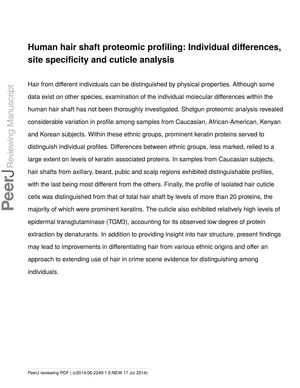Peer Review of Human Hair Shaft Proteomic Profiling: Individual Differences, Site Specificity, and Cuticle Analysis
August 2014

TLDR The research found that people's hair proteins vary, especially by ethnicity and body part, which could help identify individuals in forensic science.
The study conducted shotgun proteomic analysis on human hair shafts and found significant variation in protein profiles among individuals, particularly within ethnic groups such as Caucasian, African-American, Kenyan, and Korean subjects. Keratin proteins were key in distinguishing individual profiles, while differences between ethnic groups were less pronounced and mostly based on levels of keratin-associated proteins. The study also revealed that hair shafts from different body sites (axillary, beard, pubic, and scalp) of Caucasian subjects had unique profiles, with scalp hair being the most distinct. Additionally, the protein profile of isolated hair cuticle cells differed from that of the total hair shaft, with a higher presence of keratins and epidermal transglutaminase (TGM3), which contributed to the cuticle's resistance to protein extraction by denaturants. These findings could enhance the differentiation of hair in forensic science, aiding in the identification of individuals at crime scenes.

